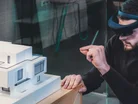How Virtual Reality is Helping Reshape Construction Design

Virtual reality (VR) is transforming the way buildings are designed and constructed. The technology is allowing architects and engineers to create immersive 3D environments that help them visualise – and interact with – their designs before construction begins.
VR technology in construction design has evolved rapidly in recent years. High-resolution displays, improved motion tracking, and more powerful graphics processors have enhanced the realism and interactivity of virtual environments.
Such advances have made VR an increasingly valuable tool for architects and engineers, allowing them to walk through virtual buildings, examining every detail and making changes in real-time.
VR offers several benefits in building design. It reduces errors and rework by identifying issues early in the design process, which can lead to significant cost savings during construction.
The technology also improves communication between project stakeholders. Complex design concepts can be more easily understood when experienced in a virtual environment.
VR can make construction projects greener
Using VR, designers can also identify potential hazards and develop mitigation strategies before work begins on site. Sustainability, meanwhile, is another area where VR is proving invaluable. It allows designers to simulate energy performance and to optimise building systems for efficiency in virtual environments.
Several large multinational construction companies have adopted VR in their design processes.
Swedish multinational construction company Skanska, uses VR to improve collaboration and decision-making on complex projects.
“Virtual reality is improving the way Skanska collaborates with clients and also with the design team,” says Kelsey Stein, who at the time of speaking was National Preconstruction Technology Director with Skanska, but is now Industry Lead, Advisory Services, Asia Pacific, with Autodesk – a company that provides technology for sector including architecture, engineering, construction, product design and manufacturing.
“At Skanska, we used an Autodesk Revit model. We published it to the cloud using Live. One click of a button and we were in virtual reality. Live helps Skanska’s clients visualise their projects. It also helps us convey the cost implications of their different design decisions. This means they are better placed to make decisions earlier on in the design process.”
This, she continues, benefits everybody, because VR “helps save time and money on projects”.
VR helps construction client engagement
On this note, global design, architecture, and engineering firm HOK employs VR to enhance client engagement, by creating virtual walkthroughs of proposed designs, allowing clients to experience spaces before construction begins.
Foster + Partners, a British architectural design and engineering firm, also uses VR to create immersive presentations for clients, allowing stakeholders to experience designs firsthand – leading, as Kelsey Stein pointed out, to more-informed decisions.
Immersive technology is also changing building design by enabling more iterative and collaborative processes. Architects can now quickly test multiple design options and gather feedback from clients and stakeholders in virtual environments.
And the technology allows, too, for better spatial understanding. Designers can assess proportions, lighting, and ergonomics more accurately than with traditional 2D drawings or static 3D models.
Balfour Beatty and Bechtel: VR pioneers in construction
VR can also be used for training purposes. International infrastructure group Balfour Beatty uses VR to train workers in safety procedures. The company creates virtual simulations of construction sites to prepare workers for potential hazards.
Meanwhile, Bechtel, one of the largest construction companies in the US, uses VR for project planning and visualisation, to optimise construction sequences and logistics.
The adoption of VR in construction design, however, does face some challenges. High initial costs for equipment and software can be a barrier in an industry with notoriously narrow margins, and there is also a learning curve associated with VR technology. Training staff to use these systems effectively also requires time and resources.
Yet despite these challenges, the benefits of VR in construction design are clear. As the technology becomes more accessible and user-friendly, its adoption is likely to accelerate across the industry, in every facet of the construction process – from design and planning to training and safety.
- AWS' Mission to Reduce the Environmental Impact of BuildingsTechnology & AI
- HCM: Harnessing AI to Reduce Machinery DowntimeTechnology & AI
- Why LanzaJet's SAF Plant is a Game-Changer for AviationSustainability & Green Building
- LinkedIn: How Green Skills Talent Gap Impacts ConstructionSustainability & Green Building




